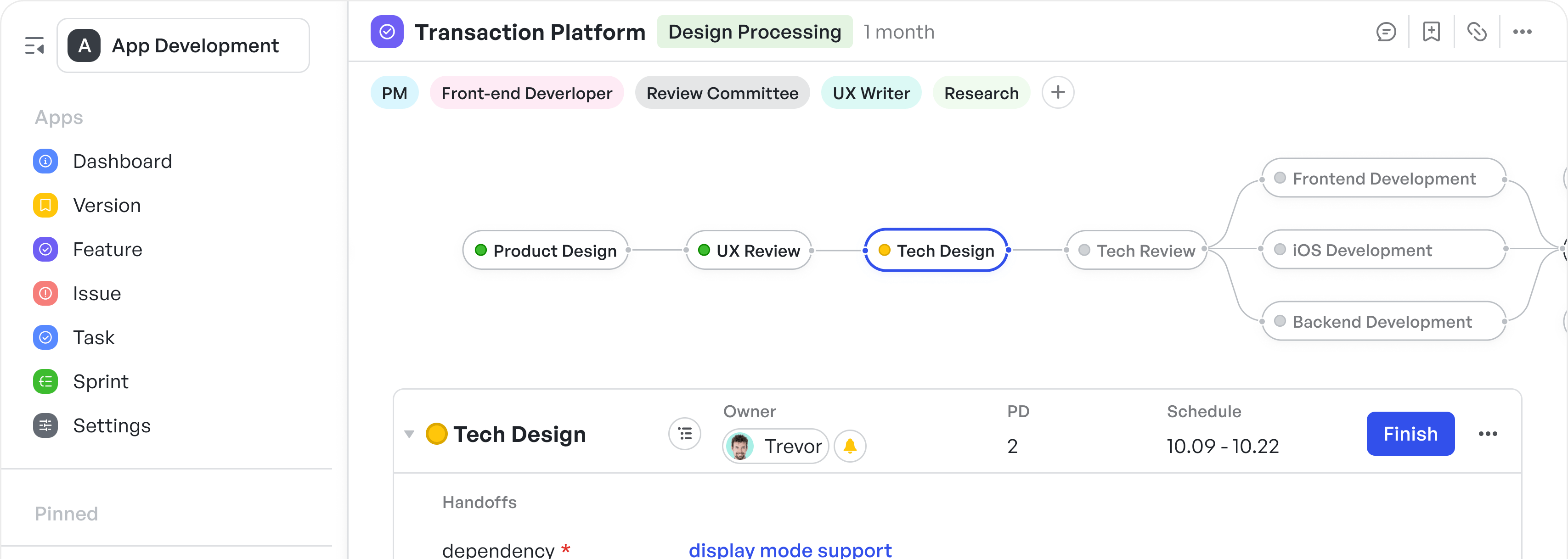Managing a 1000-piece, double-sided jigsaw puzzle might actually feel easier than managing a project.
With a puzzle, you know exactly what you’re aiming for - the finished image. There’s a sense of certainty. You just need to figure out where each piece goes.
However, complex project management is anything but straightforward. Unlike the puzzle, your goal can constantly shift and evolve. One minute, you're aiming for a specific deliverable. Next, the scope changes.
There’s no one way to solve the problem as project management has multiple variables. You've got team schedules, budget fluctuations, and client demands, and you have to manage all these moving pieces simultaneously.
Now, there are project management tools such as ClickUp and Trello that make the job less demanding. They give you the structure you need, helping you organize tasks, set priorities, and keep your team aligned. And each tool offers something different that caters to different types of task management and project requirements.
To help you decide whether you need ClickUp vs. Trello, or perhaps an alternative like Meegle, we have compared the tools in detail and highlighted how Meegle offers a more balanced solution.
ClickUp vs. Trello Compared
Both ClickUp and Trello are project management tools that cater to a wide range of user needs.
Trello’s appeal lies in its simplicity and visual appeal, especially for smaller teams or individuals. On the other hand, ClickUp is known for its versatility and customization options, making it useful for scaling businesses or teams requiring advanced features.
Trello offers a free plan that’s sufficient for small projects, but its premium plans—starting at $5 per user/month—are better suited for growing teams needing advanced capabilities. ClickUp also provides a free plan, but offers value-packed paid plans, starting at $7 per user/month, which include many features that Trello reserves for higher tiers.
These tools differ significantly in terms of integrations, customization, and scalability, so understanding your team's specific needs is key to choosing the right fit.
Overview of ClickUp
250px|700px|reset
加载中,请稍后
ClickUp project management tool (Source: ClickUp)
ClickUp is a project management software that handles task management as well as complex workflows. It’s used in teams managing multiple projects with advanced needs like time tracking and workflow automation.
Through its single platform where you can create tasks, assign deadlines, and monitor project progress, ClickUp offers an integrated experience compared to other simpler tools. Due to its versatility, it is used by software developers, marketing teams, and enterprises.
Key features of ClickUp
- Goal tracking and OKR management: Help teams stay aligned with objectives and monitor performance.
- Advanced planning tools: Features like Gantt charts, task dependencies, and sprint management bring structure to planning and execution.
- Built-in collaboration tools: Time tracking, team chat, and document creation ensure smooth communication and coordination.
- Innovative planning aids: Mind maps and workload tools support efficient task planning and distribution.
- Automations: Handle repetitive workflows, saving time for more critical tasks.
- Versatile views and integrations: Native email integration and multiple project views keep teams organized and adaptable as projects evolve.
These features make ClickUp useful for growing businesses that require better project management tools for scaling while ensuring seamless collaboration.
Overview of Trello
250px|700px|reset
加载中,请稍后
Trello project management tool (Source: Trello)
Trello is a simple project management tool designed for teams seeking clarity and collaboration without added complexity. Its card-based system lets teams create boards, lists, and cards to visually organize workflows, making task tracking easy.
Key features of Trello
- Power-Ups: Enhance boards with custom features like calendar views, integrations, and automation tools.
- Collaborative simplicity: @mentions, comments, and file attachments ensure smooth communication.
- Butler automation: Automate repetitive tasks like moving cards, setting reminders, or assigning team members.
- Customizable boards: Adapt Trello to fit any workflow, from personal to professional.
- Mobile-friendly: Access and update projects on the go with its mobile app.
ClickUp vs. Trello: A side-by-side comparison
Let’s examine the key features of ClickUp vs. Trello:
ClickUp vs. Trello: Integration capabilities and ecosystem
ClickUp and Trello have the ability to boost productivity through seamless integrations with other tools. The level of integration significantly impacts the range of tasks teams can efficiently manage within each platform. By connecting these tools to your existing tech stack, workflows run more smoothly, ensuring enhanced functionality and collaboration.
Let's assess how ClickUp vs. Trello align with different workflows:
ClickUp integration
For teams that rely on multiple SaaS tools, ClickUp allows for smoother integration with widely used platforms like Slack, Google Drive, Zoom, Zapier, and more. These integrations help teams communicate, share files, and automate repetitive tasks.
It also has built-in apps such as time tracking and goal setting. No third-party apps are needed.
For example:
- Time tracking: Monitor how much time your team spends on tasks without additional tools.
- Goal-setting tools: Create objectives, measure progress, and align them with your projects.
What makes ClickUp unique is its ability to consolidate various tools into one interface. Teams can track project progress, manage resources, and handle client communications without jumping between different platforms.
These integrations help teams scale by optimizing their workflows and reducing manual processes, which is useful for larger organizations with complex needs.
Trello integration
Trello is well-known for its Power-Ups, which allow teams to extend its core functionality by integrating with tools like Google Drive, Jira, Salesforce, and even automation tools like Meegle.
This flexibility makes Trello a good choice for teams expanding their workflows incrementally.
However, the free version of Trello limits the number of Power-Ups you can use. For teams working on more extensive projects, this can be a bottleneck as essential integrations might require upgrading to a paid plan.
Trello's USP is its intuitive design, yet expanding its capabilities through Power-Ups requires time and attention to detail. Reaching the level of functionality found in ClickUp involves layering tools and customizing features, inviting teams to invest in crafting a system that fits their evolving needs.
How Meegle outperforms ClickUp and Trello
Meegle is the perfect middle ground between ClickUp’s advanced features and Trello’s simplicity. It gives you the best of both worlds—powerful integrations and an easy-to-use interface.
Unlike Trello, which limits integration of its free plan, Meegle lets you connect to as many tools as you need, like CRMs, email platforms, and file-sharing apps, even in the basic plan.
If ClickUp feels too complicated to set up, Meegle has you covered with a super-simple design that gets your team up and running in no time. Automate tasks, track progress in real-time, and connect with tools like Slack and Google Workspace—all without the hassle.
With Meegle, you can handle any project, big or small, with confidence and ease. It’s the tool your team needs to stay on top of things and get more done, stress-free.
Here's a comparison table for all three software:
Strengths and weaknesses of ClickUp vs. Trello
Understanding the strengths and weaknesses of ClickUp and Trello can help you determine which is the best fit for your team. Both tools excel in different areas and serve distinct purposes.
ClickUp's strengths
- Comprehensive feature set ideal for managing complex projects
- Custom workflows that adapt to unique team needs
- Excellent for large teams requiring detailed workload management
- Built-in tools for time tracking and project reporting
- Advanced automation capabilities for repetitive tasks
ClickUp's weaknesses
- A steeper learning curve for new users
- Overwhelming for new users due to its extensive features
- Initial setup may be time-consuming for smaller teams.
Trello's strengths
- User-friendly interface, ideal for beginners
- Quick to set up and simple to use for managing small projects
- Great for teams looking for a straightforward project management tool
- Offers unlimited boards and robust collaboration tools
- Integrates well with third-party apps through Power-Ups.
Trello's weaknesses
- Lacks scalability for complex projects or large teams
- Limited advanced features like Gantt charts and task dependencies
- The free version restricts the number of Power-Ups available.
Now that you know what ClickUp and Trello bring to the table, let’s talk about an alternative that combines the best of both.
Meet Meegle: a tool that’s as easy to use as Trello but powerful enough to handle complex projects like ClickUp. It’s flexible, customizable, and designed to grow with your team.
Let’s take a closer look at how Meegle could be the perfect fit for your needs.
How Meegle outperforms ClickUp and Trello
250px|700px|reset
加载中,请稍后
Meegle - project management tool of the next gen
Managing tasks and projects effectively is essential for any team. While the older solutions ClickUp and Trello lead the market, the newer Meegle, with a fresh set of features that enhance workflows and promote collaboration, is a strong contender.
Meegle offers the best of both worlds.
- Trello → simplicity (Ideal for small tasks.)
- ClickUp → complexity (Great for large, intricate teams.)
- Meegle → flexibility (You get the best out of both—simplified task tracking with advanced features when needed.)
- Simplifying complex projects with visual workflows
- Simplifying complex projects with visual workflows
250px|700px|reset
加载中,请稍后
Creating a workflow in Meegle
Meegle’s visual workflow system takes complex projects and turns them into structured, easy-to-follow sequences. Nodes represent individual tasks, creating a clear map of the entire workflow. Every task connects logically, making it easy to track progress and understand dependencies.
Each node includes precise details—task descriptions, assigned roles, and required actions—so responsibilities remain clear at all times. As tasks move forward, automation advances the workflow without manual intervention, preventing delays and reducing miscommunication.
Pre-built templates offer a structured foundation, allowing teams to implement organized workflows without starting from scratch. These templates maintain consistency while adapting to specific project needs.
Complex projects often lead to confusion, missed steps, and inefficiencies. Visual workflows eliminate these by laying everything out in an intuitive sequence. With automation handling transitions and dependencies mapped out, teams can focus on execution rather than managing moving parts.
- Offering flexible collaboration than Trello and greater ease of use than ClickUp
- Offering flexible collaboration than Trello and greater ease of use than ClickUp
250px|700px|reset
加载中,请稍后
Creating task roadmap in Meegle
Meegle structures team collaboration to reflect real-world workflows rather than imposing rigid hierarchies. Teams can operate across departments, bringing together cross-functional groups for large-scale projects, or remain within a single department for focused execution. Instead of forcing a rigid structure like Trello or bothering users with too many configuration options like ClickUp, Meegle adapts to how work actually flows, allowing teams to configure their collaboration model based on project needs rather than software limitations.Each team setup reflects the nature of the tasks at hand. Cross-functional teams can pull in contributors from different disciplines, ensuring that marketing, development, and operations work in sync without losing visibility into each other’s contributions. Department-specific teams can function independently while still integrating with larger organizational workflows when needed.
Roles within these teams connect directly to assigned tasks, making it clear who is responsible for what. There’s no need for external role-mapping documents or constant clarification in meetings. New team members can instantly see their place in the workflow, reducing ramp-up time and minimizing confusion.
- A scalable solution for growing teams
- A scalable solution for growing teams
250px|700px|reset
加载中,请稍后
Check the full progress of the project with Meegle
As companies expand, so do their needs. The best project management tool for today might not meet the requirements of tomorrow. For growing teams, scalability is a must.
Meegle’s flexibility allows teams to scale effortlessly. Meegle has a lightweight architecture that allows for smooth performance, even as project complexity scales. ClickUp can slow down performance due to the extensive features.
ClickUp vs Trello: which one should you choose?
Selecting the right project management tool goes beyond comparing features but finding a solution that aligns with your team’s style and goals. Trello is perfect for simple task management, and ClickUp caters to intricate workflows.
However, Meegle bridges the gap by delivering robust functionality without the steep learning curve, making it an ideal choice for growing teams seeking flexibility and efficiency.
Why consider Meegle?
250px|700px|reset
加载中,请稍后
See projects through teams with Meegle
If your team has found ClickUp too complex or Trello too limiting, Meegle might be the sweet spot.
Meegle is designed to:
- Provide intuitive, visual workflows that are easy to adopt.
- Integrate seamlessly with tools you already use.
- Scale with your team as your needs grow.
Meegle could be a great fit for teams that require more than what Trello offers but don’t want the learning curve of ClickUp.
Meegle: the perfect project management tool for your team
Deciding between ClickUp and Trello depends on your team’s needs. Trello is great for small teams needing simplicity, while ClickUp is ideal for managing complex projects using its extensive features. However, Trello’s limited scalability and ClickUp’s steep learning curve can leave teams searching for a better balance.
That’s where Meegle steps in—offering the perfect mix of simplicity and advanced functionality to streamline workflows.
Ready to find your perfect match? Meegle combines the ease of Trello with the power of ClickUp in a user-friendly platform that scales with your needs.
FAQs
Which one is better: ClickUp or Trello?
The choice depends on your team’s needs and project complexity. ClickUp is ideal for teams managing complex projects, offering advanced features like task dependencies, time tracking, and customizable workflows. On the other hand, Trello is perfect for smaller teams or simpler projects, thanks to its intuitive interface and straightforward task management.
If you’re looking for a balance between the two—combining ease of use with powerful features—Meegle is the perfect alternative. It offers flexibility, scalability, and advanced functionality without the steep learning curve.
What is ClickUp best used for?
ClickUp is useful for teams managing complex projects or large workflows. It’s best for project managers looking for an all-in-one platform to handle task management, project planning, task dependencies, and advanced features like Gantt charts and time tracking.
How does Meegle compare to ClickUp and Trello?
Meegle stands out because it combines the best aspects of both ClickUp and Trello. It provides simplicity for Trello while offering the advanced features found in ClickUp. Meegle also offers seamless integrations, task tracking, and flexible workflows, making it a scalable solution for growing teams that need both simplicity and power.





